Abstract
Purpose:
To investigate the effects of dexamethasone (DEX) on the production of nitric oxide (NO) and its enzymatic synthetic pathway in cultured human trabecular meshwork (HTM) cells.
Methods:
Primarily cultured HTM cells were exposed to 0, 10, 100, 1000 nM of DEX for 3 days. In addition, 100 μ M sepiapterin, 100 μ M ascorbic acid, and 10 μ M methotrexate were co-exposed to DEX. The cellular survival and nitrite production rates were assessed by MTT assay and Griess assay, respectively.
Results:
DEX did not significantly affect the survival of cultured HTM cells. DEX decreased the NO production in a dose− dependent manner. With co-exposure of DEX, ascorbic acid nullified the DEX-induced decrease of NO production. Sepiapterin and methotrexate did not affect DEX-induced decrease of NO production.
Go to : 
References
1. Alvarado J, Murphy C, Juster R. Trabecular meshwork cellularity in primary open-angle glaucoma and nonglaucomatous normals. Ophthalmology. 1984; 91:564–79.

2. Rohen JW, Lütjen-drecoll E, Flügel C, et al. Ultrastructure of the trabecular meshwork in untreated cases of primary open-angle glaucoma. Exp Eye Res. 1993; 56:683–92.
3. Schuman JS, Erickson K, Nathanson JA. Nitrovasodilator effects on intraocular pressure and ocular facility in monkeys. Exp Eye Res. 1994; 58:99–105.
4. Wana RF, Podos SM. Effect of the topical application of nitro-glycerin on intraocular pressure in normal and glaucomatous monkeys. Exp Eye Res. 1995; 60:337–9.
5. Nathanson JA, McKee M. Alteration of ocular nitric oxide synthase in human glaucoma. Invest Ophthalmol Vis Sci. 1995; 36:1774–84.
6. Matsuo T. Basic nitric oxide production is enhanced by hydraulic pressure in cultured human trabecular cells. Br J Ophthalmol. 2000; 84:631–5.
7. Francois J. Corticosteroid glaucoma. Ann Ophthalmol. 1977; 9:1075–80.
8. Becker B. Diabetes and primary open-angle glaucoma. Am J Ophthalmol. 1971; 1:1–16.
9. Brodsky SV, Morrishow AM, Dharia N, et al. Glucose scavenging of nitric oxide. Am J Physiol. 2001; 280:480–6.

10. Moncada S, Palmer RM, Higgs EA. Nitric oxide: physiology, pathophysiology, and pharmacology. Pharmacol Rev. 1991; 43:109–42.
11. Bredt DS, Snyder SH. Nitric oxide: a physiologic messenger molecule. Annu Rev Biochem. 1994; 63:175–95.

12. Brüne B, Knethen A, Sandau KB. Nitric oxide and its role in apoptosis. Eur J Pharmacol. 1998; 351:261–72.

13. Gross SS, Levi R. Tetrahydrobiopterin synthesis. An absolute requirement for cytokine-induced nitric oxide generation by vascular smooth muscle. J Biol Chem. 1992; 267:25722–9.

14. Nathanson JA, McKee M. Identification of an extensive system of nitric oxide-producing cells in the ciliary muscle and outflow pathway. Invest Ophthalmol Vis Sci. 1995; 36:1765–73.
15. Geyer O, Podos SM, Mittag T. Nitric oxide synthase activity in tissues of the bovine eyes. Graefes Arch Clin Exp Ophthalmol. 1997; 235:786–93.
16. Meyer P, Champion C, Schlotzer-Schrehardt U, et al. Localization of nitric oxide synthase isoforms in porcine ocular tissues. Curr Eye Res. 1999; 18:375–80.

17. Weinreb RN, Bloom E, Baxter JD, et al. Detection of gluco-cortocoid receptors in cultured human trabecular cells. Invest Ophthalmol Vis Sci. 1981; 21:403–7.
18. Mosmann T. Rapid colorimetric assay for cellular growth and survival: Application to proliferation and cytotoxicity assays. J Immunol Methods. 1983; 65:55–63.

19. Green LC, Wagner DA, Glogoski J, et al. Analysis of nitrate, nitrite and [15N]nitrate in biologic fluids. Anal Biochem. 1982; 126:131–8.
20. Polansky JR, Weinreb RN, Baxter JD, Alvarado J. Human trabecular cells. I. Establishment in tissue culture and growth characteristics. Invest Ophthalmol Vis Sci. 1979; 18:1043–9.
21. Alvarado JA, Wood I, Polansky JR. Human trabecular cells. II. Growth pattern and ultrastructural characteristics. Invest Ophthalmol Vis Sci. 1982; 23:464–78.
22. Wordinger RJ, Clark AF. Effects of glucocortocoids on the trabecular meshwork: Towards a better understanding of glaucoma. Prog Ret Eye Res. 1999; 5:629–67.
23. Clark AF, Wilson K, McCartney MD, et al. Glucocorticoid− induced formation of cross-linked actin networks in cultured human trabecular meshwork cells. Invest Ophthalmol Vis Sci. 1994; 35:281–94.
24. Zhang X, Clark AF, Yorio T. Interactions of endothelin-1 with dexamethasone in primary cultured human trabeculae meshwork cells. Invest Ophthalmol Vis Sci. 2003; 44:5301–8.
25. Clark AF, Steely HT, Dickerson JE, et al. Glucocorticoid induction of the glaucoma gene MYOCin human and monkey trabecular meshwork cells and tissues. Invest Ophthalmol Vis Sci. 2001; 42:1769–80.
26. Cheng LE, Ueda J, Wentz-hunter K, Yue BY. Age independent expression of myocillin in the human trabecular meshwork. Int J Mol Med. 2002; 10:33–40.
27. Alp NJ, Channon KM. Regulation of endothelial nitric oxide synthase by tetrahydrobiopterin in vascular disease. Arterioscler Thromb Vasc Biol. 2004; 24:413–20.

28. Padgaonkar V, Giblin FJ, Leverenz V, et al. Studies of H2O2− induced effects on cultured bovine trabecular meshwork cells. J Glaucoma. 1994; 3:123–31.
29. Vasa M, Kristin Breitschopf K, Zeiher AM, Dimmeler S. Nitric oxide activates telomerase and delays endothelial cell Senescience. Circ Res. 2000; 87:540–2.
30. Zhou L, Li Y, Yue BY. Oxidative stress affects cytoskeletal structure and cell-matrix interactions in cells from ocular tissue: the trabecular meshwork. J Cell Physiol. 1999; 180:182–9.
31. Kurz DJ, Decary S, Hong Y, et al. Chronic oxidative stress compromises telomere integrity and accelerates the onset of senescence in human endothelial cells. J Cell Sci. 2004; 117:2417–26.

32. von Zglinicki T. Role of oxidative stress in telomere length regulation and replicative senescence. Ann N Y Acad Sci. 2000; 908:99–110.

33. Wei YH. Oxidative stress and mitochondrial DNA mutations in human aging. Proc Soc Exp Biol Med. 1998; 217:53–63.

34. Furumoto K, Inoue E, Nagao N, et al. Age-dependent telomere shortening is slowed down by enrichment of intracellular vitamin C via suppression of oxidative stress. Life Sci. 1998; 63:935–48.

35. Grierson I, Howes RC. Age-related depletion of the cell population in the human trabecular meshwork. Eye. 1987; 1:204–10.

36. Alvarado J, Murphy C, Juster R. Trabecular meshwork cellularity in primary open-angle glaucoma and nonglaucomatous normals. Ophthalmology. 1984; 91:564–79.

37. Millard CB, Tripathi BJ, Tripathi RC. Age-related changes in protein profiles of the normal human trabecular meshwork. Exp Eye Res. 1987; 45:623–31.

38. Schchschabel DO, Binninger E. Aging of trabecular meshwork cells of the human eye in vitro. Z Gerontol. 1990; 23:133–5.
Go to : 
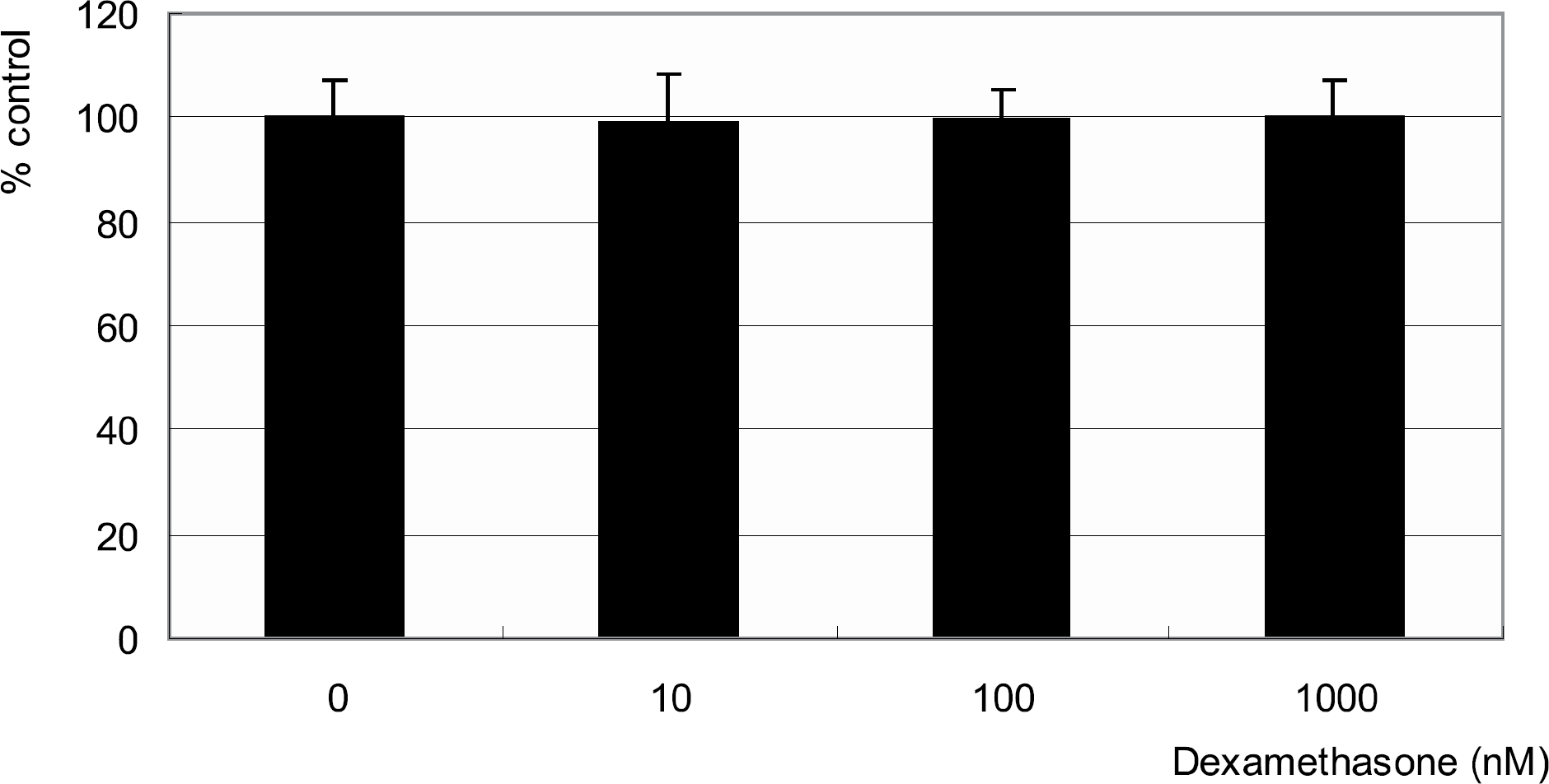 | Figure 1.Effect of dexamethasone on the survival of cultured trabecular meshwork cells. Three-day exposure of dexamethasone did not significantly affect the survival of trabecular meshwork cells compared to non-exposed control (p>0.05). |
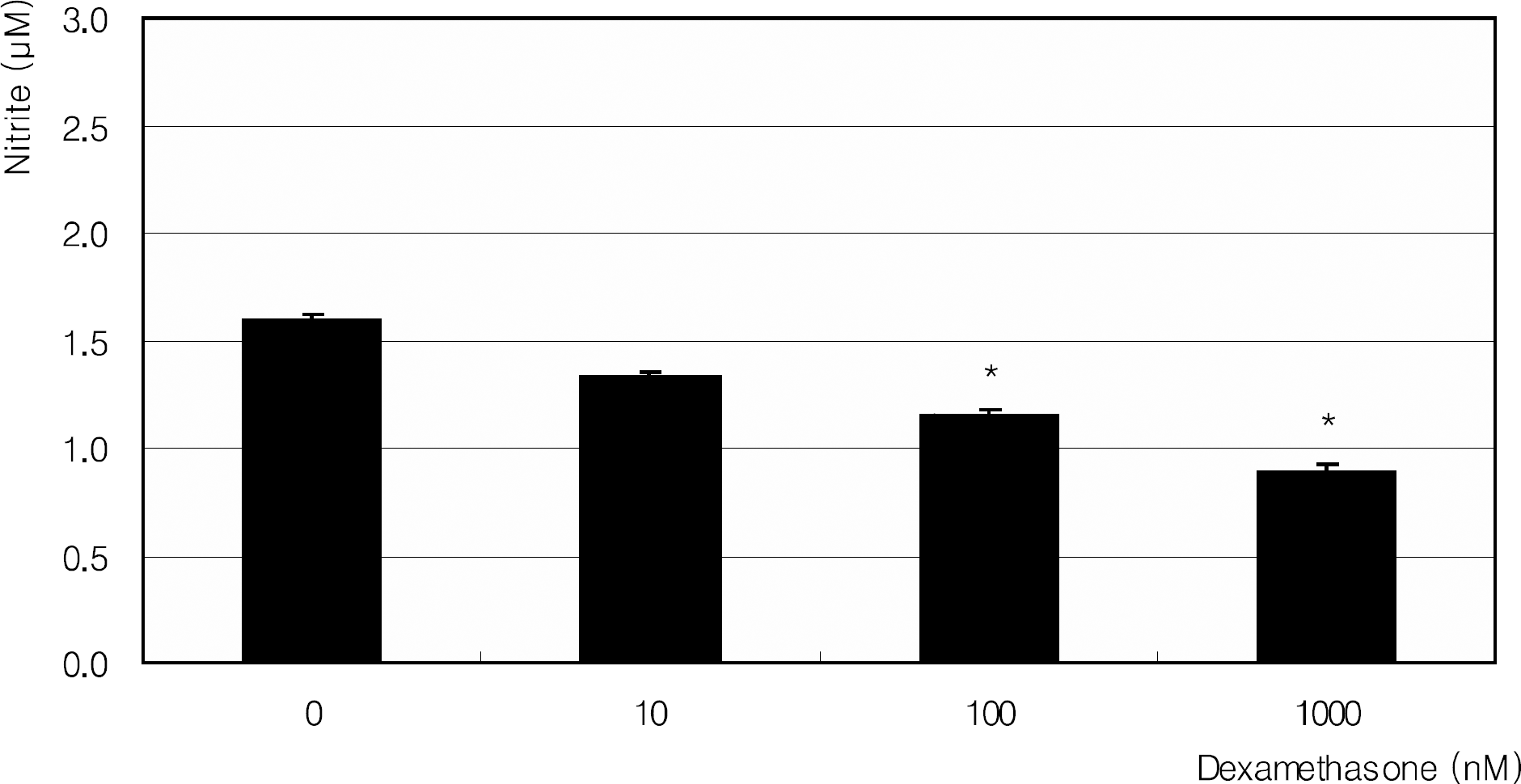 | Figure 2.Effect of dexamethasone on the production of nitric oxide in cultured trabecular meshwork cell exposed for 3 days. Dexamethasone decreased nitric oxide production (∗ p<0.05). |
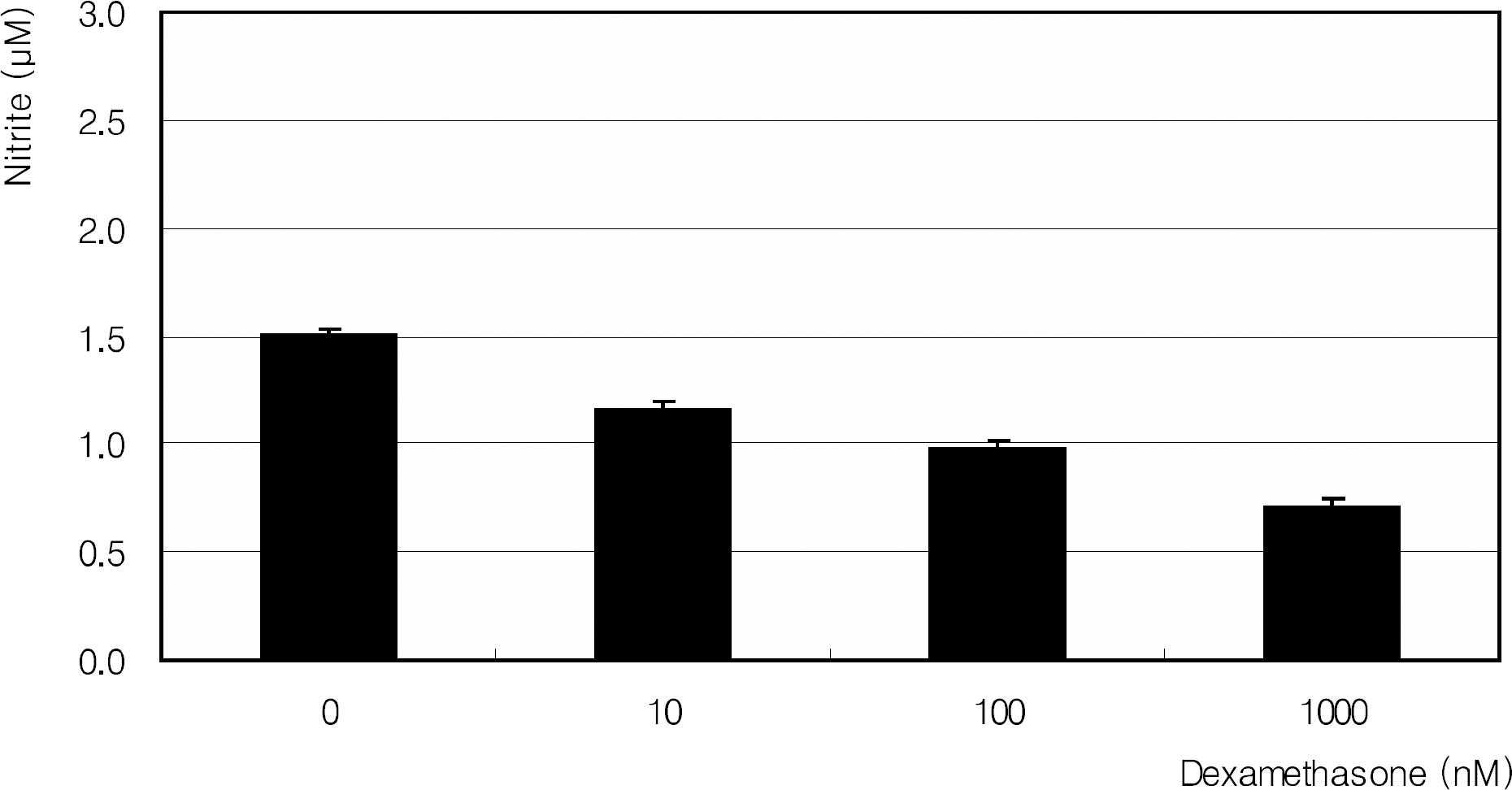 | Figure 3.Effect of 100 μM sepiapterin on the production of nitric oxide after co-exposed to dexamethasone for 3 days. Sepiapterin further decreased nitric oxide production compared to non-exposed control (∗ p<0.05). |




 PDF
PDF ePub
ePub Citation
Citation Print
Print


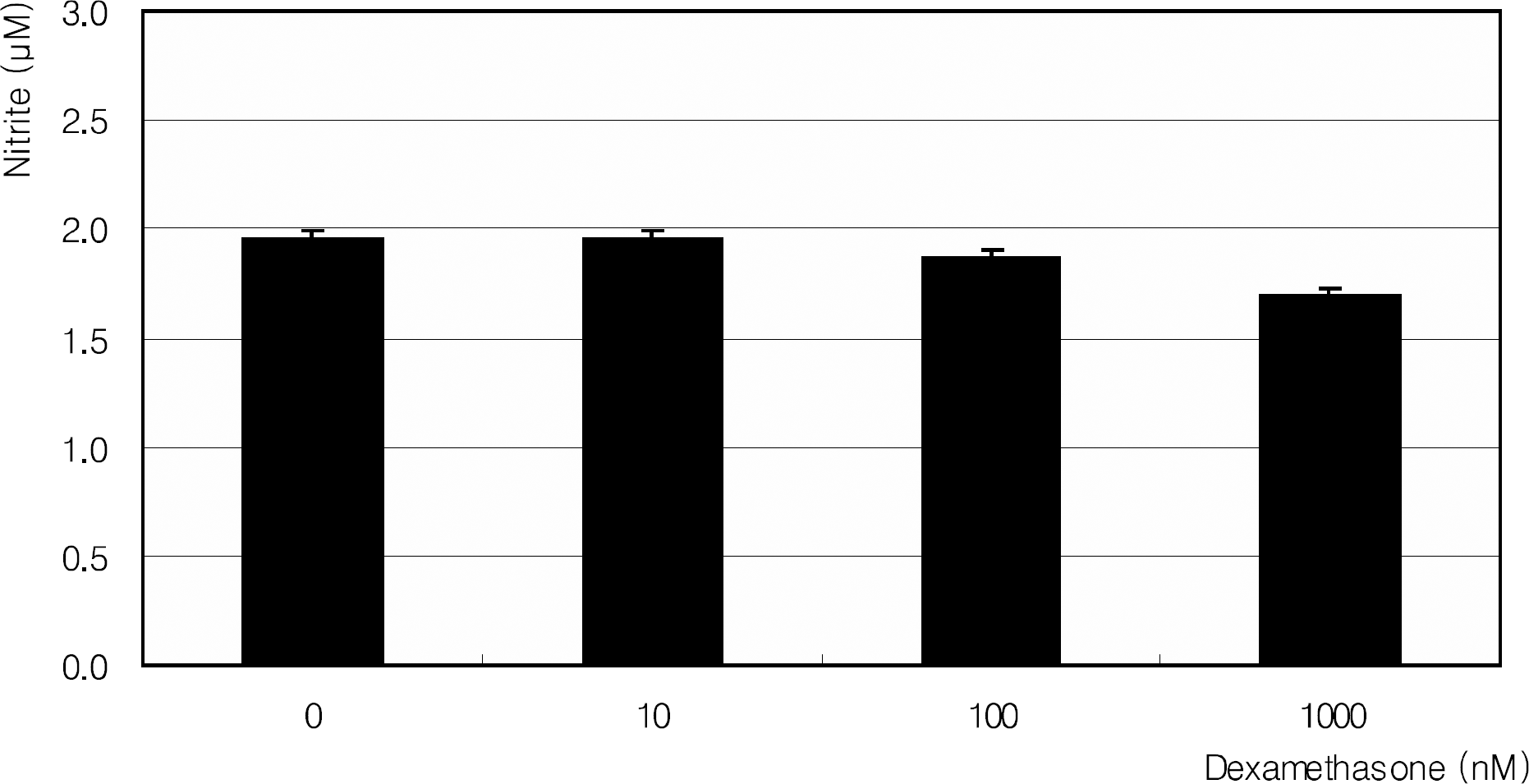
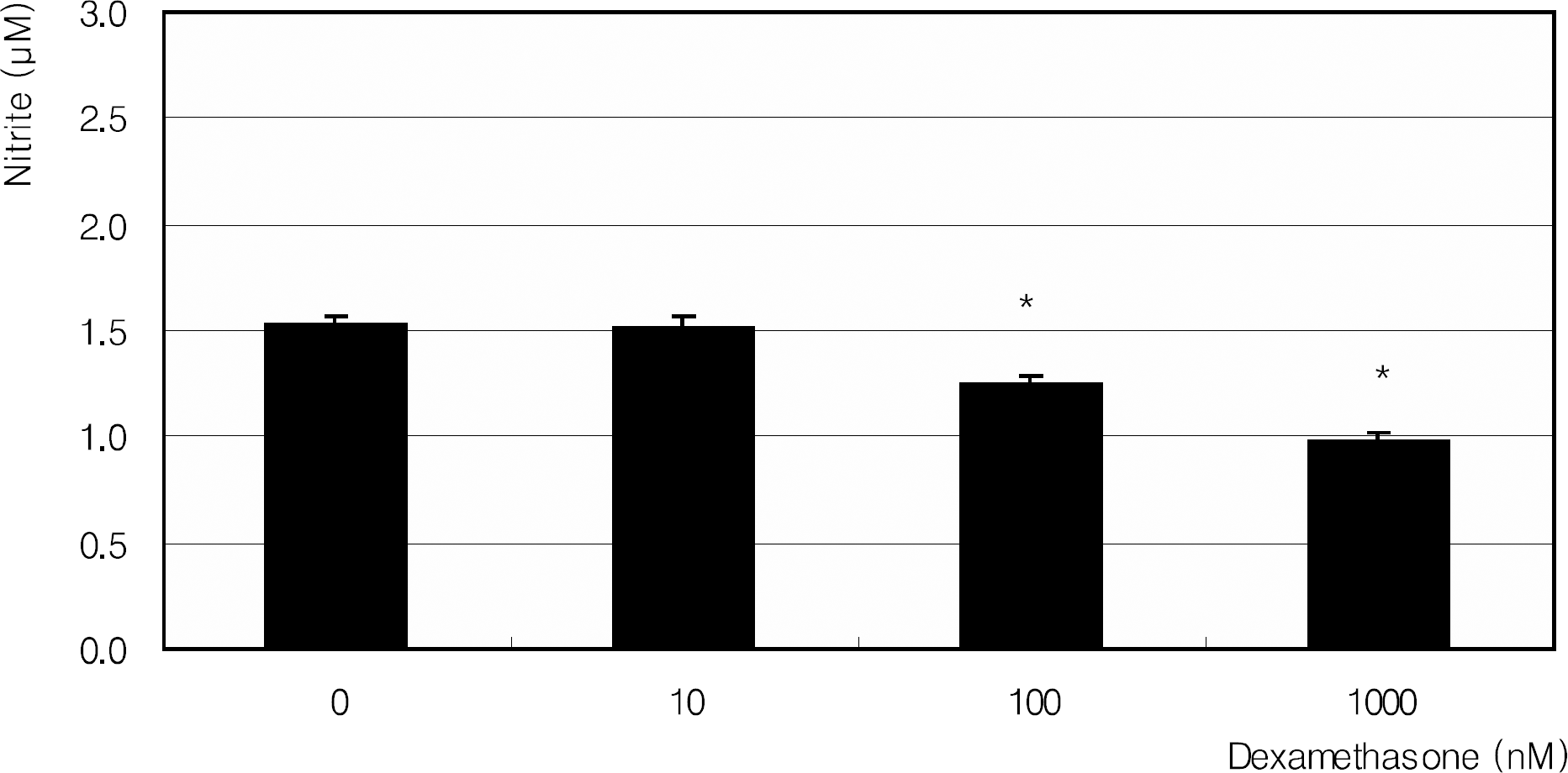
 XML Download
XML Download